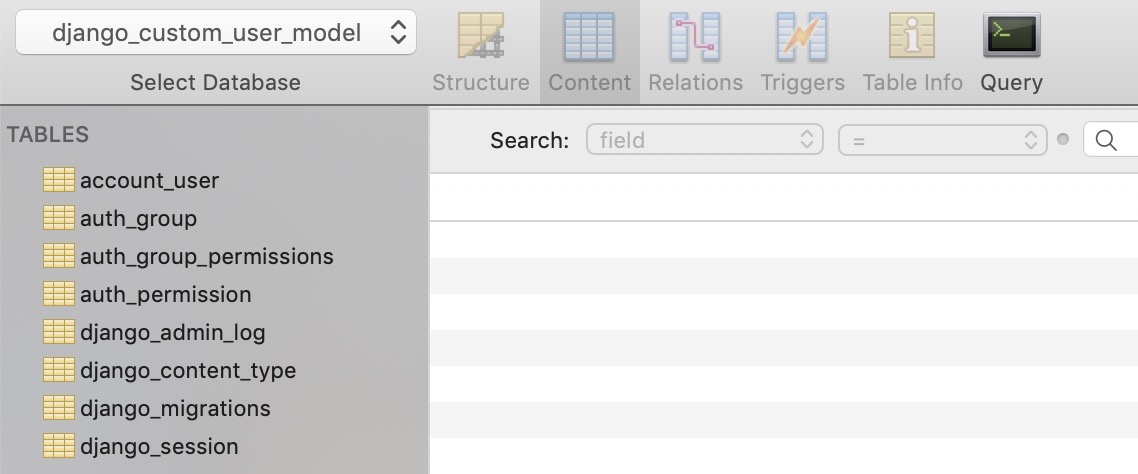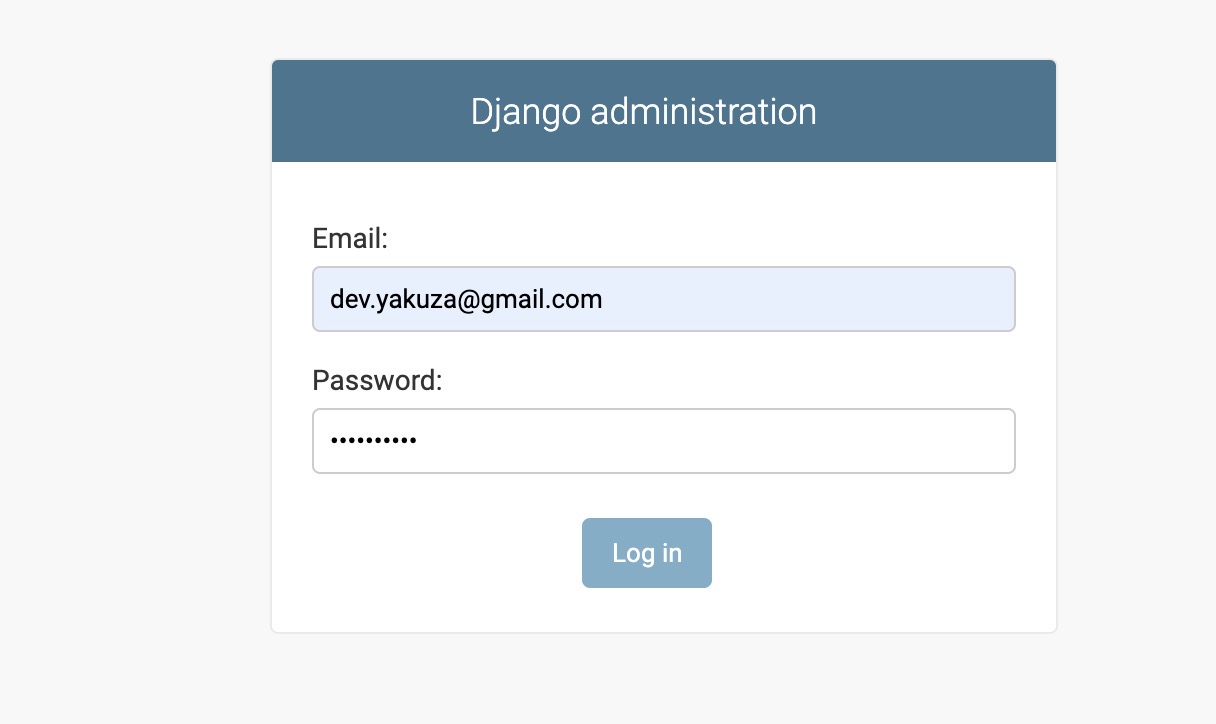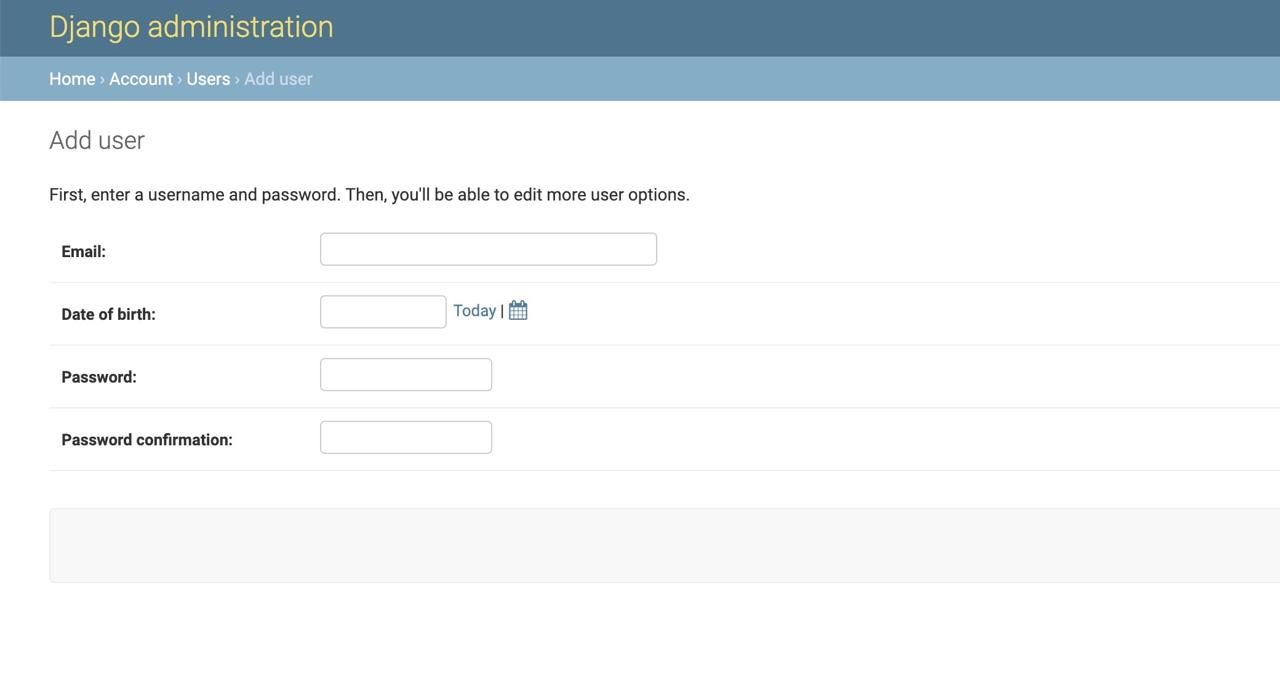Outline
when we try to login via django basic User Model, we should login with username. also, sometimes, we develop the service, we want to store user’s gender, birthday or profile image. in this blog post, we’ll see how to create Custom User Model in django. this blog post contents is based on django official site.
- django official site: https://docs.djangoproject.com/en/dev/topics/auth/customizing/#a-full-example
you can see full code of this blog post on github. see the link below.
Prepare django project
execute the command below to create django project.
django-admin startproject django_custom_user_model
connect database only by seeing the blog below.(don’t execute python manage.py migrate.)
execute the command below to create new django app named account.
python manage.py startapp account
and then open django_custom_user_model/settings.py file and modify it to add new app like below.
...
INSTALLED_APPS = [
...
'account',
]
...
Create Custom User Model
open and modify account/models.py to create Custom User Model like below.
from django.db import models
from django.contrib.auth.models import (BaseUserManager, AbstractBaseUser)
class UserManager(BaseUserManager):
def create_user(self, email, date_of_birth, password=None):
if not email:
raise ValueError('Users must have an email address')
user = self.model(
email=self.normalize_email(email),
date_of_birth=date_of_birth,
)
user.set_password(password)
user.save(using=self._db)
return user
def create_superuser(self, email, date_of_birth, password):
user = self.create_user(
email,
password=password,
date_of_birth=date_of_birth,
)
user.is_admin = True
user.save(using=self._db)
return user
class User(AbstractBaseUser):
email = models.EmailField(
verbose_name='email',
max_length=255,
unique=True,
)
date_of_birth = models.DateField()
is_active = models.BooleanField(default=True)
is_admin = models.BooleanField(default=False)
objects = UserManager()
USERNAME_FIELD = 'email'
REQUIRED_FIELDS = ['date_of_birth']
def __str__(self):
return self.email
def has_perm(self, perm, obj=None):
return True
def has_module_perms(self, app_label):
return True
@property
def is_staff(self):
return self.is_admin
let’s see more details.
...
from django.contrib.auth.models import (BaseUserManager, AbstractBaseUser)
...
class UserManager(BaseUserManager):
...
class User(AbstractBaseUser):
...
we need to implement 2 classes (BaseUserManager, AbstractBaseUser) to create Custom User Model. BaseUserManager is a helper class to create an user, and Custom User Model class should be inherited AbstractBaseUser class.
the helper class(class UserManager(BaseUserManager):) has 2 functions.
create_user(*username_field*, password=None, **other_fields)create_superuser(*username_field*, password, **other_fields)
as you can see, first parameter is username. we want to use email not username, so we pass email instead of username. other parts are just storing the data, so skip to introduce.
let’s see Custom User Model(class User(AbstractBaseUser):).
...
email = models.EmailField(
verbose_name='email',
max_length=255,
unique=True,
)
date_of_birth = models.DateField()
is_active = models.BooleanField(default=True)
is_admin = models.BooleanField(default=False)
...
this model has email, date_of_birth, is_active, is_admin fields. is_active, is_admin fields are required fields for User Model in django.
...
objects = UserManager()
USERNAME_FIELD = 'email'
...
this is required parts to create User Model. we set the model uses our helper class (objects = UserManage()), and username field is email(USERNAME_FIELD = 'email').
def has_perm(self, perm, obj=None):
return True
def has_module_perms(self, app_label):
return True
@property
def is_staff(self):
return self.is_admin
we need to implement this part to make Custom USer Model for base Use Model.
def has_perm(self, perm, obj=None):: return True for having permission. if return Object, we need to check the permission by the object.def has_module_perms(self, app_label):: return True for accessing the app models.def is_staff(self):: return True to make user login django administrator page.
Modify Administrator Page
we need to modify the administrator page to manage the user in django admin page.
Create Form
we need to make new forms for Custom User Model to manage user information in django admin page. create and modify account/forms.py like below.
from django import forms
from django.contrib.auth.forms import ReadOnlyPasswordHashField
from .models import User
class UserCreationForm(forms.ModelForm):
password1 = forms.CharField(label='Password', widget=forms.PasswordInput)
password2 = forms.CharField(
label='Password confirmation', widget=forms.PasswordInput)
class Meta:
model = User
fields = ('email', 'date_of_birth')
def clean_password2(self):
password1 = self.cleaned_data.get("password1")
password2 = self.cleaned_data.get("password2")
if password1 and password2 and password1 != password2:
raise forms.ValidationError("Passwords don't match")
return password2
def save(self, commit=True):
user = super().save(commit=False)
user.set_password(self.cleaned_data["password1"])
if commit:
user.save()
return user
class UserChangeForm(forms.ModelForm):
password = ReadOnlyPasswordHashField()
class Meta:
model = User
fields = ('email', 'password', 'date_of_birth',
'is_active', 'is_admin')
def clean_password(self):
return self.initial["password"]
let’s see more details.
from django import forms
from django.contrib.auth.forms import ReadOnlyPasswordHashField
from .models import User
class UserCreationForm(forms.ModelForm):
...
class UserChangeForm(forms.ModelForm):
...
we need to make user creation form and user data modification form.
class UserCreationForm(forms.ModelForm):
password1 = forms.CharField(label='Password', widget=forms.PasswordInput)
password2 = forms.CharField(
label='Password confirmation', widget=forms.PasswordInput)
class Meta:
model = User
fields = ('email', 'date_of_birth')
def clean_password2(self):
password1 = self.cleaned_data.get("password1")
password2 = self.cleaned_data.get("password2")
if password1 and password2 and password1 != password2:
raise forms.ValidationError("Passwords don't match")
return password2
def save(self, commit=True):
user = super().save(commit=False)
user.set_password(self.cleaned_data["password1"])
if commit:
user.save()
return user
user creation form has password1, password2,
class Meta:
model = User
fields = ('email', 'date_of_birth')
and email, date_of_birth of our User Model. check password2 is matching password1 via def clean_password2(self): function. lastly, store the data via def save(self, commit=True):.
user data modification form is more simple.
class UserChangeForm(forms.ModelForm):
password = ReadOnlyPasswordHashField()
class Meta:
model = User
fields = ('email', 'password', 'date_of_birth',
'is_active', 'is_admin')
def clean_password(self):
return self.initial["password"]
get user password via ReadOnlyPasswordHashField() and show it.(can not modify).
class Meta:
model = User
fields = ('email', 'password', 'date_of_birth',
'is_active', 'is_admin')
get user’s email, password, date_of_birth, is_activate, is_admin fields, and when store the data, password will be kept because of def clean_password(self): function.
Apply Form to Admin Page
let’s apply Forms we’ve created above to django administrator page. open and modify account/admin.py like below.
from django.contrib import admin
from django.contrib.auth.models import Group
from django.contrib.auth.admin import UserAdmin as BaseUserAdmin
from .forms import UserChangeForm, UserCreationForm
from .models import User
class UserAdmin(BaseUserAdmin):
form = UserChangeForm
add_form = UserCreationForm
list_display = ('email', 'date_of_birth', 'is_admin')
list_filter = ('is_admin',)
fieldsets = (
(None, {'fields': ('email', 'password')}),
('Personal info', {'fields': ('date_of_birth',)}),
('Permissions', {'fields': ('is_admin',)}),
)
add_fieldsets = (
(None, {
'classes': ('wide',),
'fields': ('email', 'date_of_birth', 'password1', 'password2')}
),
)
search_fields = ('email',)
ordering = ('email',)
filter_horizontal = ()
admin.site.register(User, UserAdmin)
admin.site.unregister(Group)
let’s see more details.
class UserAdmin(BaseUserAdmin):
form = UserChangeForm
add_form = UserCreationForm
we set django admin page use our user creation form and user data modification form.
list_display = ('email', 'date_of_birth', 'is_admin')
list_filter = ('is_admin',)
fieldsets = (
(None, {'fields': ('email', 'password')}),
('Personal info', {'fields': ('date_of_birth',)}),
('Permissions', {'fields': ('is_admin',)}),
)
add_fieldsets = (
(None, {
'classes': ('wide',),
'fields': ('email', 'date_of_birth', 'password1', 'password2')}
),
)
we set how our Custom User Model show in django admin page.
admin.site.register(User, UserAdmin)
admin.site.unregister(Group)
we register our Custom User Model and Admin Form, and unregister Group that django basically provides.
Configure Custom User Model
we need to configure to make our Custom User Model be basic authentication user model in django. open and modify django_custom_user_model/settings.py like below.
...
AUTH_USER_MODEL = 'account.User'
Create Table
we’ve not created tables in Prepare django project section above. because we want django to use our Custom User Model instead of basic user model. execute the command below to prepare Custom User Model table.
python manage.py makemigrations account
and execute the command below to create tables.
python manage.py migrate
Check
let’s see our Custom User Model is applied well. first, check the tables we’ve created above via database tool.

we can see there is no auth_user table. execute the command below to create django superuser.
python manage.py createsuperuser
and then, we can see new process to create superuser like below.
Email: [email protected]
Date of birth: 2019-06-06
Password:
Password (again):
Superuser created successfully.
execute the command below to start django test server and open django admin page(http://127.0.0.1:8000/admin).
python manage.py runserver
you can see email is required when we login.

lastly, when we add new user or modify user information, we can see the forms like below.

Completed
we’ve seen how to create and use Custom User Model in django. now, we can use Custom User Model instead of basic user model to store more user information for our service!
Reference
- django installation
- Start django Project
- Use Models in django
- django Administrator Page
- django Routing
- django ORM
- django View
- django Form
- Upload django project to Heroku
- https://docs.djangoproject.com/en/dev/topics/auth/customizing/#a-full-example
Was my blog helpful? Please leave a comment at the bottom. it will be a great help to me!
App promotion
Deku.Deku created the applications with Flutter.If you have interested, please try to download them for free.




